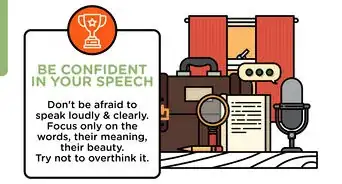This article was co-authored by Gale McCreary. Gale McCreary is the Founder and Chief Coordinator of SpeechStory, a nonprofit organization focused on improving communication skills in youth. She was previously a Silicon Valley CEO and President of a Toastmasters International chapter. She has been recognized as Santa Barbara Entrepreneurial Woman of the Year and received Congressional recognition for providing a Family-Friendly work environment. She has a BS in Biology from Stanford University.
wikiHow marks an article as reader-approved once it receives enough positive feedback. In this case, 87% of readers who voted found the article helpful, earning it our reader-approved status.
This article has been viewed 161,132 times.
Whether you're narrating a book professionally or reading a poem out loud for class, how you deliver a story makes all the difference. You'll need to get comfortable with the material and understand what makes for a great, engaging narrative. Once you do so, you'll bring the story to life and leave your audience perched on the edge of their seats.
Steps
Speaking Techniques
-
1Get comfortable reading and speaking at the same time. This is really important if you're telling a story or poem by reading it from the page. You can also memorize, which can help, but you want to make sure you know how to read something out loud.
- Read it more than once. Especially if you're going to be performing in front of people, you want to read over what you're narrating multiple times, so that you are accustomed to the words and you can look up at your audience.
- Catch the rhythm of the words. You'll notice for poems and for stories and even stories that are only verbal, that the length of the sentences and the words used create a sort of rhythm. Get yourself accustomed to this rhythm through practice so you can render the story or poem well, out loud.
- Try to avoid simply reading the story or poem off the page. Narration means that you're taking an active part in engaging your audience and performing the narrative. Look up while you're reading so that you meet the eyes of your audience.
-
2Modify your tone, speed, and volume. To tell the story in an engaging manner you will want to vary your voice in terms of speed, volume, tone, cadence. If you speak only in one tone (monotone) you'll bore your listeners, no matter how interesting the story itself is.
- You want your tone to match the tone of the story. For example, you don't want to speak confidingly when you're telling an epic tale (like Beowulf), but you wouldn't want your voice to get all epic if you were narrating a humorous Shell Silverstein poem, or a light fluffy romance.
- Make sure that you're narrating slowly. When you read aloud, or tell a story to an audience, you want to speak more slowly than you would if you were simply having a conversation. Speaking slowly allows you to capture your audience and allows them to fully appreciate the story or poem. It's good to have water with you when you're narrating and to stop and take a sip so that you can slow down.
- You want to project your voice, but you don't want to shout. Breathe and speak from your diaphragm. As an exercise to help you figure out how to do this: stand up straight with your hand on your abdomen. Breathe in and breathe out, feeling your stomach rise and fall as you do this. Count up to ten as you inhale, then count down from ten on your exhale. Your abdomen should start to relax. You will want to speak from that relaxed state.
Advertisement -
3Speak clearly. Plenty of people don't speak properly or clearly enough when they're trying to narrate. You want to make sure that your audience can hear and understand what you're saying. Avoid mumbling, or speaking too quietly.
- Articulate your sounds correctly. Articulation basically means pronouncing sounds properly, rather than pronouncing words. The sounds to focus on pronouncing are: b, d, g, dz (j in jelly), p, t, k, ts, (ch in chilly). Emphasizing these sounds will make your speaking more clear for your audience.
- Pronounce words correctly. Make sure that you know what all the words in your story or poem mean and how to say them properly. If you have trouble remembering the pronunciation write up a little guide for yourself next to the word, so that you can say it right when you're narrating.
- Avoid "umms" and placeholder words such as "like." Although fine for regular conversation, these words will make you sound less confident in your narration and will distract your audience.
-
4Stress the proper parts of the story or poem. You want to make sure that your audience understands the most important parts of the poem or story. Because you're narrating aloud you'll need to show them these parts with your voice.
- Sinking your voice into quiet tones and leaning forward to engage your audience for important parts of the story can be a great way to intrigue them. Make sure that you're still projecting even if you're speaking more quietly and carefully.
- For example: if you were narrating Harry Potter and the Philosopher's Stone (the first book) you would want to stress the parts of the story like Harry facing Voldemort or Harry winning the Quidditch match by catching the snitch in his mouth.
- Poems have specific stresses written into their structure. This means paying attention to how the poem is formatted (what the meter is) so that you know what syllables to stress in your narration.[1]
-
5Pause in the appropriate places. You want to avoid barreling through your narration. Reading or telling a story or poem aloud is not a race. Instead, make sure that you pause at appropriate points so that your audience can fully absorb what they're hearing.[2]
- Make sure you pause after a particularly humorous or emotional part of your narration to allow your audience time to react. Try to avoid skipping over the important parts of the narrative without a pause. For example: if you're telling a humorous story, you might pause as you build up to the punchline, so people start laughing as they see where the story is heading.
- Many times punctuation is a good place to have a pause. When you're reading poetry out loud, make sure that you aren't pausing at the ends of the lines, but instead where the punctuation (comma, periods, etc.) designates a pause.
- A good example of appropriate pauses is Lord of the Rings. When reading the work not out loud, you may notice the overabundance of commas, to the point that it looks like Tolkien didn't know how to use commas. Now, if you narrate the book out loud, you find that those commas hit the perfect pauses in verbal storytelling.
Having a Good Narrative
-
1Set the mood. When you're narrating something (a story, a poem, a joke) you want to make sure that you set the right mood. This means setting up the story's place and time, telling it so that the audience feels like they're there and giving the story immediacy.
- Give a little background to the story. What is the setting of it? What is the timing (did it happen in your life? someone else's? is this is a story from long ago?)? All these things can help solidify the narrative in your audience's minds.
- Tell from the proper point-of-view. Is this your story, did it happen to you? Someone you know? Is it a story people are going to be familiar with (like Cinderella, for example)? Make sure you're telling the story from the right point-of-view.
- If you're telling a story, especially one that happened to you, rather than narrating from a written story or poem, you want to tell it in present tense. This makes the narrative more immediate for your audience and sucks them into the story more easily.
-
2Have the right story structure. When you're narrating a story, especially one you've come up with yourself or has been related to you, you want to ensure you have a story structure that will interest your audience. People have been telling and narrating stories for thousands of years, so there are a few parameters that can make your story better.
- Your story should follow a cause/effect structure, no matter what the story is. This means that something happens and then something else is the effect of the cause, the first thing. Think about it with the word because. "Because of the cause, the effect happened."
- For example: your comedic story is triggered by you spilling water on the floor. That's the cause, the effect is that you slip on it in the climax of the story. "Because you spilled water on the floor earlier, you slipped on it when you were playing tag."
- Introduce the conflict early. The conflict and the resolution of the conflict is what keeps your audience interested in the story. Taking too much time introducing it, or veering away from it too often, will reduce your audience's interest. For example: if you were telling the story of Cinderella, you don't want to go on and on about her life before the step-family arrives. The step-family are the conflict in the story, so they need to be introduced early.
-
3Share the right details. Details can make or break a narrative. If you share too many details you'll overwhelm your audience, or bore them. Too few details and your audience won't get much of a feel for the narrative.
- Choose details that are relevant to the outcome of the story. To use Cinderella as an example again: you don't need to give a minute description of every chore she has to do for the step-evils, but descriptions of the chores her step-mom gives her so she can't go to the ball are important because the hinder the resolution of the story.
- You can also provide some interesting or humorous details sprinkled through the narrative. Don't overwhelm your audience with these, but a few can get some laughs or provide a deeper interest in the narrative.
- Avoid being too vague with your details. In Cinderella's case if you don't tell the audience who is throwing the ball, or where the dress and slippers come from, you'll simply confuse your listeners.
-
4Stay consistent within your story. The tale you're narrating might have dragons and magic that can take a person instantly from one place to another, but as long as it's consistent your audience can suspend disbelief. Now, however, if you add a spaceship to the mix without previous hint of science-fiction, you'll throw your audience out of the story.[3]
- You also want to make sure that the characters in your story act consistently as well. If you have a character that begins the story being super timid, they're probably not going to immediately confront their deadbeat dad without a lot of character development.
-
5Have the right length. It's hard to determine what the right length for a story or poem is. That's something that you'll have to decide for yourself, but there are definitely some things that you should consider about the length. These can help you decide how long to make it.
- A shorter story is easier to carry off, especially if you're just beginning with narration. It still takes time to make sure you have all the details right and that you hit the right tone, the right speed, and so on.
- If you are going to tell a long story make sure that it needs to be long and that it isn't boring. Sometimes you can cut details to make the long story shorter and snappier, therefore making it more interesting.
Avoiding Common Mistakes
-
1Use your voice appropriately. Two of the biggest problems that people make when they're trying to narrate are speaking too quickly and not varying their voice. These two problems tend to go together, since it's hard to vary you're voice when you're flying through your narration at the speed of light.
- Watch your breathing and your pauses, if you're worried about speaking too quickly. If you aren't taking deep, slow breaths you're probably going too fast. If you aren't pausing, then you are definitely going to fast and your audience will have difficulty keeping up.
- Make sure that you're using inflections on words and syllables, so that you aren't simply speaking in one tone. This is one of the biggest ways to keep your audience's interest, even if the story itself isn't the most interesting.
-
2Get to the story. Another problem is not getting to the story quickly enough and taking too many detours during the story. The occasional aside isn't a problem, especially if it's informative or humorous. Otherwise, stick to the main story, because that's what your audience wants to hear about.[4]
- Avoid the "pre-ramble." When you start your narration, do the briefest introduction of yourself and the work as possible. Your audience doesn't want to hear how the story came to you in a dream, etc. and etc. They want to hear the story.
- Don't ramble during the story. Keep to the basic bones of the story and don't go off onto other memories, or other immensely funny things that you just thought of. Too many side rambles and you're going to lose your audience.
-
3Avoid sharing too much opinion/insight/moral. When you're narrating a story, whether it's your own or another's, your audience does not want your moral insight. Think about the stories that you remember from your childhood (like Aesop's fables). Most, if not all, had some moral. Do you even remember it, or do you remember only the story?
- Stories are built on facts, the facts of the narrative. Following these facts will provide the moral or opinion or insight whether or not you articulate what it actually is.
-
4Practice. This seems like such an obvious step, but so often this is where people fall down when trying to narrate. You have to practice before you can effectively and entertainingly narrate something, whether it's a written poem or story, or a story you're telling that comes from your own life.
- The more you know your material, the more confident you'll appear when you're narrating. The more confident you are in your narration, the more interest your garner from your audience.
-
5Listen to other storytellers. There are people who do narration for a living: storytellers, people who do voice-overs for movies, people who read stories for books on tape.
- Watch storytellers live and see how they use their bodies (hand gestures, facial expressions), how they vary their voices, and what techniques they use to draw in their listeners.
Community Q&A
-
QuestionWhy should you not be too fast in narrating?
 Community AnswerCommunication in general needs to be proper and understandable, so, especially in narration, you must speak slowly and clearly.
Community AnswerCommunication in general needs to be proper and understandable, so, especially in narration, you must speak slowly and clearly. -
QuestionHow should I react after making a mistake on the stage in front of many people?
 Community AnswerFirstly, you should take a deep breath and relax. Just ignore the mistake and keep going with your narration.
Community AnswerFirstly, you should take a deep breath and relax. Just ignore the mistake and keep going with your narration. -
QuestionHow do I narrate song lyrics without singing?
 Community AnswerPlace the emphasis of words in different places than the song, and allow for pauses between phrases to avoid using a cadence.
Community AnswerPlace the emphasis of words in different places than the song, and allow for pauses between phrases to avoid using a cadence.
Warnings
- Try to avoid breathing and speaking from your throat or your upper chest, because you'll strain your vocal chords and tense everything up. You will start to sound strained and uncomfortable.⧼thumbs_response⧽
References
- ↑ http://www.poetryarchive.org/glossary/stress
- ↑ http://www.loc.gov/poetry/180/p180-howtoread.html
- ↑ http://www.writersdigest.com/writing-articles/by-writing-goal/write-first-chapter-get-started/3-secrets-to-great-storytelling
- ↑ http://www.craigvalentine.com/12-deadly-storytelling-mistakes-many-speakers-make/
About This Article
To narrate effectively, vary your tone, speed, and volume as you speak. Highlight the most important parts of the story by matching the tone to the scene. For example, lean forward and whisper during a dramatic part of the story, or raise your voice during a fight between characters. Remember to take pauses, especially after funny or intense moments, and include only the most relevant and interesting details. For choosing a story structure that will captivate your audience, read on!













































































